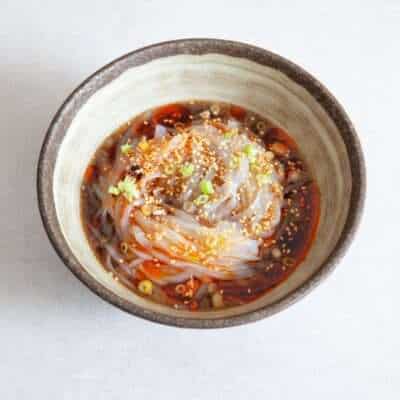Chinese Mung Bean Jelly Noodles (Liang Fen 凉粉)

They Mung Bean Jelly Noodles are super easy to make. You only need two ingredients. Mung bean starch (which you can buy online or from your local Chinese store) and water. It’s best to make them the day before or the morning of the day you want to eat them as they take 4 hours to set, but the actual time involved in making these is as long as it takes for the water to come to a simmer.
serves 2
IngredientsMung Bean Jelly Noodles
-
140g mung bean starch
-
2 garlic cloves
-
2 tbsp soy sauce
-
2 tbsp Chinese black vinegar
-
1 tsp sesame oil
-
1 tsp golden granulated sugar
-
1/4 tsp Sichuan pepper
-
2 spring onions
-
1 tbsp sesame seeds
-
2 tbsp chilli oil
Method
In a bowl, whisk the starch together with 250 ml cold water
Bring 1.1l of water to a simmer. Lower the temperature, give the starch mixture another whisk to ensure it’s equally dissolved, then slowly pour and whisk it into the hot water. Now stir the mixture until it begins to thicken and turn translucent and continue simmering until it reaches the consistency of a thick sauce (1-2 minutes). When you lift the spoon and drizzle the mixture into itself, it should form thick ripples of the surface. Pour the paste into a smooth bowl and let it set for around 4 hours at room temperature (once it’s set, you can store it in the fridge)
For the sauce, peel the garlic and grate it into a small bowl. Add the soy sauce, vinegar, sesame oil, sugar and Sichuan pepper to the bowl and mix it together. Finally, stir in 100 ml of cold water. Refrigerate for at least 30 minutes. In the meantime, finely slice the spring onions and toast the sesame seeds until golden brown.
Tip the jelly onto a plate, coat it with a little bit of cold water and use a jelly scraper to cut the noodles. Alternatively you can cut the jelly by knife into thick noodles of your choice.
Place the noodles into a bowl and pour over the cold sauce followed by the chilli oil, sliced spring onion and toasted sesame seeds. Serve cold, ideally on a warm day.

Mung Bean Jelly Noodles
Ingredients
- 140 g mung bean starch
- 2 garlic cloves
- 2 tbsp soy sauce
- 2 tbsp Chinese black vinegar
- 1 tsp sesame oil
- 1 tsp golden granulated sugar
- 1/4 tsp Sichuan pepper
- 2 spring onions
- 1 tbsp sesame seeds
- 2 tbsp chilli oil (I used Gulp)
Instructions
- In a bowl, whisk the starch together with 250 ml cold water
- Bring 1.1l of water to a simmer. Lower the temperature, give the starch mixture another whisk to ensure it’s equally dissolved, then slowly pour and whisk it into the hot water. Now stir the mixture until it begins to thicken and turn translucent and continue simmering until it reaches the consistency of a thick sauce (1-2 minutes). When you lift the spoon and drizzle the mixture into itself, it should form thick ripples of the surface. Pour the paste into a smooth bowl and let it set for around 4 hours at room temperature (once it’s set, you can store it in the fridge)
- For the sauce, peel the garlic and grate it into a small bowl. Add the soy sauce, vinegar, sesame oil, sugar and Sichuan pepper to the bowl and mix it together. Finally, stir in 100 ml of cold water. Refrigerate for at least 30 minutes. In the meantime, finely slice the spring onions and toast the sesame seeds until golden brown.
- Tip the jelly onto a plate, coat it with a little bit of cold water and use a jelly scraper to cut the noodles. Alternatively you can cut the jelly by knife into thick noodles of your choice.
- Place the noodles into a bowl and pour over the cold sauce followed by the chilli oil, sliced spring onion and toasted sesame seeds. Serve cold, ideally on a warm day.
